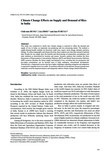This study was conducted to clarify how climate change is expected to affect the demand and supply of rice in India, an important rice-producing and rice-consuming nation. The method, a supply-demand model, includes six functions: yield, area, export, stock change, demand, and price linkage. To reflect topographic and climate diversity, these analyses use state data instead of national data. Results for rice supply show the benefits and shortcomings of temperature, precipitation, and solar radiation as determined by location and season. Scenario analyses that combine the three dimensions of Representative Concentration Pathways (RCP) and Shared Socioeconomic Pathways (SSP) scenarios elucidate the future supply and demand of rice, revealing that rice production and per-capita consumption can be boosted most if India undergoes conventional development. Alternatively, a fragmented society that faces higher challenges regarding mitigation and adaptation is expected to engender lower rice yields. To maintain sufficient rice production, the government must undertake social development projects and adequately address climate change-related difficulties.

